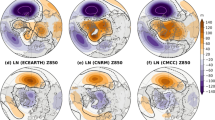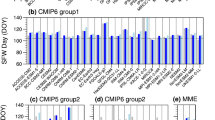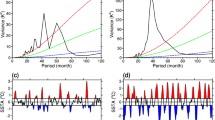Abstract
The concurrent effects of the El Niño-Southern Oscillation (ENSO) on the northern winter stratosphere have been widely recognized; however, the delayed effects of ENSO in the next winter after mature ENSO have yet to be confirmed in multi reanalyses and model simulations. This study uses three reanalysis datasets, a long-term fully coupled model simulation, and a high-top general circulation model to examine ENSO’s delayed effects in the stratosphere. The warm-minus-cold composite analyses consistently showed that, except those quick-decaying quasi-biennial ENSO events that reverse signs during July–August–September (JAS) in their decay years, ENSO events particularly those quasi-quadrennial (QQ) that persist through JAS, always have a significant effect on the extratropical stratosphere in both the concurrent winter and the next winter following mature ENSO. During the concurrent winter, the QQ ENSO-induced Pacific-North American (PNA) pattern corresponds to an anomalous wavenumber-1 from the upper troposphere to the stratosphere, which acts to intensify/weaken the climatological wave pattern during warm/cold ENSO. Associated with the zonally quasi-homogeneous tropical forcing in spring of the QQ ENSO decay years, there appear persistent and zonally quasi-homogeneous temperature anomalies in the midlatitudes from the upper troposphere to the lower stratosphere until summer. With the reduction in ENSO forcing and the PNA responses in the following winter, an anomalous wavenumber-2 prevails in the extratropics. Although the anomalous wave flux divergence in the upper stratospheric layer is still dominated by wavenumber-1, it is mainly caused by wavenumber-2 in the lower stratosphere. However, the wavenumber-2 activity in the next winter is always underestimated in the model simulations, and wavenumber-1 activity dominates in both winters.














Similar content being viewed by others
References
Angell JK (1981) Comparison of variations in atmospheric quantities with sea surface temperature variations in the equatorial eastern Pacific. Mon Weather Rev 109:230–243. doi:10.1175/1520-0493(1981)109<0230:coviaq>2.0.co;2
Barnett TP (1991) The interaction of multiple time scales in the tropical climate system. J Clim 4:269–285. doi:10.1175/15200442(1991)004<0269:tiomts>2.0.co;2
Bejarano L, Jin F-F (2008) Coexistence of equatorial coupled modes of ENSO. J Clim 21:3051–3067. doi:10.1175/2007jcli1679.1
Calvo N, Giorgetta MA, Garcia-Herrera R, Manzini E (2009) Nonlinearity of the combined warm ENSO and QBO effects on the Northern Hemisphere polar vortex in MAECHAM5 simulations. J Geophys Res 114:D13019. doi:10.1029/2008jd011445
Calvo N, Garcia RR, Randel WJ, Marsh DR (2010) Dynamical mechanism for the increase in tropical upwelling in the lowermost tropical stratosphere during warm ENSO events. J Atmos Sci 67:2331–2340. doi:10.1175/2010jas3433.1
Camp CD, Tung KK (2007) Stratospheric polar warming by ENSO in winter: a statistical study. Geophys Res Lett 34:L14703. doi:10.1029/2006gl028521
Chen W, Takahashi M, Graf H-F (2003) Interannual variations of stationary planetary wave activity in the north winter troposphere and stratosphere and their relations to NAM and SST. J Geophys Res 108:4797. doi:10.1029/2003jd003834
Chen SF, Chen W, Yu B, Graf HF (2013) Modulation of the seasonal footprinting mechanism by the boreal spring Arctic Oscillation. Geophys Res Lett 40:6384–6389. doi:10.1002/2013gl058628
Danabasoglu G, Bates SC, Briegleb BP, Jayne SR, Jochum M, Large WG, Peacock S, Yeager SG (2012) The CCSM4 ocean component. J Clim 25:1361–1389. doi:10.1175/jcli-d-11-00091.1
Dee DP, Uppala SM, Simmons AJ et al (2011) The ERA-Interim reanalysis: configuration and performance of the data assimilation system. Q J R Meteorol Soc 137:553–597. doi:10.1002/qj.828
Duchon CE (1979) Lanczos filtering in one and two dimensions. J Appl Meteorol 18:1016–1022. doi:10.1175/1520-0450(1979)018<1016:lfioat>2.0.CO;2
Ebita A, Kobayashi S, Ota Y et al (2011) The Japanese 55-year reanalysis “JRA-55”: an interim report. Sola 7:149–152. doi:10.2151/sola.2011-038
Enfield DB, Mayer DA (1997) Tropical Atlantic sea surface temperature variability and its relation to El Niño-Southern Oscillation. J Geophys Res 102:929–945. doi:10.1029/96jc03296
Evtushevsky OM, Kravchenko VO, Hood LL, Milinevsky GP (2015) Teleconnection between the central tropical Pacific and the Antarctic stratosphere: spatial patterns and time lags. Clim Dyn 44:1841–1855. doi:10.1007/s00382-014-2375-2
Eyring V, Waugh DW, Bodeker GE et al (2007) Multimodel projections of stratospheric ozone in the 21st century. J Geophys Res 112:D16303. doi:10.1029/2006jd008332
Eyring V, Shepherd T, Waugh D (eds) (2010a) Stratospheric processes and their role in climate: SPARC report on the evaluation of chemistry-climate models. WCRP-132, WMO/TD-1526, SPARC Rep. 5, p 408. http://www.sparc-climate.org/publications/sparc-reports/
Eyring V, Cionni I, Bodeker GE et al (2010b) Multi-model assessment of stratospheric ozone return dates and ozone recovery in CCMVal-2 models. Atmos Chem Phys 10:9451–9472. doi:10.5194/acp-10-9451-2010
Garcia RR, Marsh DR, Kinnison DE, Boville BA, Sassi F (2007) Simulation of secular trends in the middle atmosphere, 1950–2003. J Geophys Res 112:D09301. doi:10.1029/2006jd007485
García-Herrera R, Calvo N, Garcia RR, Giorgetta MA (2006) Propagation of ENSO temperature signals into the middle atmosphere: a comparison of two general circulation models and ERA-40 reanalysis data. J Geophys Res 111:D06101. doi:10.1029/2005jd006061
Garfinkel CI, Hartmann DL (2007) Effects of the El Niño-Southern oscillation and the quasi-biennial oscillation on polar temperatures in the stratosphere. J Geophys Res 112:D19112. doi:10.1029/2007jd008481
Garfinkel CI, Hartmann DL (2008) Different ENSO teleconnections and their effects on the stratospheric polar vortex. J Geophys Res 113:D18114. doi:10.1029/2008jd009920
Garfinkel CI, Hurwitz MM, Waugh DW, Butler AH (2012) Are the teleconnections of Central Pacific and Eastern Pacific El Niño distinct in boreal wintertime? Clim Dyn 41:1835–1852. doi:10.1007/s00382-012-1570-2
Gent PR, Danabasoglu G, Donner LJ et al (2011) The community climate system model version 4. J Clim 24:4973–4991. doi:10.1175/2011jcli4083.1
Hamilton K (1995) Interannual variability in the northern hemisphere winter middle atmosphere in control and perturbed experiments with the GFDL SKYHI general circulation model. J Atmos Sci 52:44–66. doi:10.1175/1520-0469(1995)052<0044:ivitnh>2.0.co;2
Hegyi BM, Deng Y (2011) A dynamical fingerprint of tropical Pacific sea surface temperatures on the decadal-scale variability of cool-season Arctic precipitation. J Geophys Res 116:D20121. doi:10.1029/2011jd016001
Hegyi BM, Deng Y, Black RX, Zhou RJ (2014) Initial transient response of the winter polar stratospheric vortex to idealized equatorial Pacific sea surface temperature anomalies in the NCAR WACCM. J Clim 27:2699–2713. doi:10.1175/jcli-d-13-00289.1
Holland MM, Bailey DA, Briegleb BP, Light B, Hunke E (2012) Improved sea ice shortwave radiation physics in CCSM4: the impact of melt ponds and aerosols on arctic sea ice. J Clim 25:1413–1430. doi:10.1175/jcli-d-11-00078.1
Hu Z-Z, Kumar A, Xue Y, Jha B (2014) Why were some La Niñas followed by another La Niña? Clim Dyn 42:1029–1042. doi:10.1007/s00382-013-1917-3
Huang B, Hu Z-Z, Kinter JL, Wu Z, Kumar A (2012) Connection of stratospheric QBO with global atmospheric general circulation and tropical SST. Part I: methodology and composite life cycle. Clim Dyn 38:1–23. doi:10.1007/s00382-011-1250-7
Ishii M, Shouji A, Sugimoto S, Matsumoto T (2005) Objective analyses of sea-surface temperature and marine meteorological variables for the 20th century using ICOADS and the KOBE collection. Int J Climatol 25:865–879. doi:10.1002/joc.1169
Jackman CH, Marsh DR, Vitt FM, Garcia RR, Randall CE, Fleming EL, Frith SM (2009) Long-term middle atmospheric influence of very large solar proton events. J Geophys Res 114:D11304. doi:10.1029/2008jd011415
Jiang N, Neelin JD, Ghil M (1995) Quasi-quadrennial and quasi-biennial variability in the equatorial Pacific. Clim Dyn 12(2):101–112. doi:10.1007/bf00223723
Jin F-F, An S-I, Timmermann A, Zhao J (2003) Strong El Niño events and nonlinear dynamical heating. Geophys Res Lett 30:1120. doi:10.1029/2002gl016356
Kalnay E, Kanamitsu M, Kistler R et al (1996) The NCEP/NCAR 40-year reanalysis project. Bull Am Meteorol Soc 77:437–471. doi:10.1175/1520-0477(1996)077<0437:tnyrp>2.0.co;2
Kim KY, Kim YY (2002) Mechanism of Kelvin and Rossby waves during ENSO events. Meteorol Atmos Phys 81:169–189. doi:10.1007/s00703-002-0547-9
Klein SA, Soden BJ, Lau NC (1999) Remote sea surface temperature variations during ENSO: evidence for a tropical atmospheric bridge. J Clim 12:917–932. doi:10.1175/1520-0442(1999)012<0917:rsstvd>2.0.co;2
Kobayashi S, Ota Y, Harada Y, Ebita A et al (2015) The JRA-55 reanalysis: general specifications and basic characteristics. J Meteorol Soc Jpn 93:5–48. doi:10.2151/jmsj.2015-001
Kumar A, Hoerling MP (2003) The nature and causes for the delayed atmospheric response to El Niño. J Clim 16:1391–1403. doi:10.1175/1520-0442-16.9.1391
Labitzke K, van Loon H (1989) The Southern Oscillation. Part IX: the influence of volcanic eruptions on the Southern Oscillation in the stratosphere. J Clim 2:1223–1226. doi:10.1175/1520-0442(1989)002<1223:tsopit>2.0.co;2
Lau NC, Leetmaa A, Nath MJ, Wang HL (2005) Influences of ENSO-induced Indo-Western Pacific SST anomalies on extratropical atmospheric variability during the boreal summer. J Clim 18:2922–2942. doi:10.1175/jcli3445.1
Li Q, Ren RC, Cai M, Wu GX (2012) Attribution of the summer warming since 1970s in Indian Ocean Basin to the inter-decadal change in the seasonal timing of El Niño decay phase. Geophys Res Lett 39:L12702. doi:10.1029/2012gl052150
Manzini E, Giorgetta MA, Esch M, Kornblueh L, Roeckner E (2006) The influence of sea surface temperatures on the northern winter stratosphere: ensemble simulations with the MAECHAM5 model. J Clim 19:3863–3881. doi:10.1175/jcli3826.1
Marsh DR, Garcia RR, Kinnison DE, Boville BA, Sassi F, Solomon SC, Matthes K (2007) Modeling the whole atmosphere response to solar cycle changes in radiative and geomagnetic forcing. J Geophys Res 112:D23306. doi:10.1029/2006jd008306
Marsh DR, Mills MJ, Kinnison DE, Lamarque J-F, Calvo N, Polvani LM (2013) Climate Change from 1850 to 2005 Simulated in CESM1(WACCM). J Clim 26:7372–7391. doi:10.1175/jcli-d-12-00558.1
Matthes K, Marsh DR, Garcia RR, Kinnison DE, Sassi F, Walters S (2010) Role of the QBO in modulating the influence of the 11 year solar cycle on the atmosphere using constant forcings. J Geophys Res 115:D18110. doi:10.1029/2009jd013020
Neale RB, Richter J, Park S, Lauritzen PH, Vavrus SJ, Rasch PJ, Zhang MH (2013) The mean climate of the Community Atmosphere Model (CAM4) in forced SST and fully coupled experiments. J Clim 26:5150–5168. doi:10.1175/jcli-d-12-00236.1
Newell RE, Weare BC (1976) Factors governing tropospheric mean temperature. Science 194:1413–1414. doi:10.1126/science.194.4272.1413
Plumb RA (1985) On the three-dimensional propagation of stationary waves. J Atmos Sci 42(3):217–229
Rao J, Ren RC (2016) A decomposition of ENSO’s impacts on the northern winter stratosphere: competing effect of SST forcing in the tropical Indian Ocean. Clim Dyn 46:3689–3707. doi:10.1007/s00382-015-2797-5
Rao J, Ren RC, Yang Y (2014) Numerical simulations of the impacts of tropical convective heating on the intensity of the northern winter stratospheric polar vortex. Chin J Atmos Sci 38(6):1159–1171. doi:10.3878/j.issn.1006-9895.1404.13268 (in Chinese)
Rao J, Ren RC, Yang Y (2015) Parallel comparison of the northern winter stratospheric circulation in reanalysis and in CMIP5 models. Adv Atmos Sci 32(7):952–966. doi:10.1007/s00376-014-4192-2
Rayner NA, Parker DE, Horton EB, Folland CK, Alexander LV, Rowell DP, Kent EC, Kaplan A (2003) Global analyses of sea surface temperature, sea ice, and night marine air temperature since the late nineteenth century. J Geophys Res 108:4407. doi:10.1029/2002jd002670
Reid G, Gage K, McAfee J (1989) The thermal response of the tropical atmosphere to variations in equatorial Pacific sea surface temperature. J Geophys Res 94:14705–14716. doi:10.1029/jd094id12p14705
Ren RC (2012a) Study of the lag-coupling between the timescale ENSO events and the stratospheric circulation in the past 60 years and its mechanism. Acta Meteorol Sin 70: 520–535. doi:10.11676/qxxb2012.043 (in Chinese)
Ren RC (2012b) Seasonality of the lagged relationship between ENSO and the Northern Hemispheric polar vortex variability. Atmos Ocean Sci Lett 5:113–118. doi:10.1080/16742834.2012.11446975
Ren RC, Cai M, Xiang C, Wu G (2012) Observational evidence of the delayed response of stratospheric polar vortex variability to ENSO SST anomalies. Clim Dyn 38:1345–1358. doi:10.1007/s00382-011-1137-7
Richter JH, Sassi F, Garcia RR (2010) Toward a physically based gravity wave source parameterization in a general circulation model. J Atmos Sci 67(1):136–156. doi:10.1175/2009jas3112.1
Saravanan R, Chang P (2000) Interaction between tropical Atlantic variability and El Niño-Southern Oscillation. J Clim 13:2177–2194. doi:10.1175/1520-0442(2000)013<2177:ibtava>2.0.co;2
Sassi F, Kinnison D, Boville BA, Garcia RR, Roble R (2004) Effect of El Niño-Southern Oscillation on the dynamical, thermal, and chemical structure of the middle atmosphere. J Geophys Res 109:D17108. doi:10.1029/2003jd004434
Taguchi M, Hartmann DL (2006) Increased occurrence of stratospheric sudden warmings during El niño as simulated by WACCM. J Clim 19:324–332. doi:10.1175/jcli3655.1
Taylor KE, Stouffer RJ, Meehl GA (2012) An overview of CMIP5 and the experiment design. Bull Am Meteorol Soc 93:485–498. doi:10.1175/bams-d-11-00094.1
Tozuka T, Yamagata T (2003) Annual ENSO. J Phys Oceanogr 33:1564–1578. doi:10.1175/2414.1
Uppala SM, Kallberg PW, Simmons AJ et al (2005) The ERA-40 re-analysis. Q J R Meteorol Soc 131:2961–3012. doi:10.1256/qj.04.176
van Loon H, Zerefos C, Repapis C (1982) The Southern Oscillation in the stratosphere. Mon Weather Rev 110:225–229. doi:10.1175/1520-0493(1982)110<0225:tsoits>2.0.co;2
Vimont DJ, Battisti DS, Hirst AC (2001) Footprinting: a seasonal connection between the tropics and mid-latitudes. Geophys Res Lett 28:3923–3926. doi:10.1029/2001gl013435
Wallace JM, Chang FC (1982) Interannual variability of the wintertime polar vortex in the Northern Hemisphere middle stratosphere. J Meteorol Soc Jpn 60:149–155
Wang B, An SI (2005) A method for detecting season-dependent modes of climate variability: S-EOF analysis. Geophys Res Lett 32:L15710. doi:10.1029/2005gl022709
Wei K, Chen W, Huang R (2007) Association of tropical Pacific sea surface temperatures with the stratospheric Holton-Tan Oscillation in the Northern Hemisphere winter. Geophys Res Lett 34:L16814. doi:10.1029/2007gl030478
Xie F, Li J, Tian W, Feng J, Huo Y (2012) Signals of El Niño Modoki in the tropical tropopause layer and stratosphere. Atmos Chem Phys 12:5259–5273. doi:10.5194/acp-12-5259-2012
Yulaeva E, Wallace JM (1994) The signature of ENSO in global temperature and precipitation fields derived from the microwave sounding unit. J Clim 7:1719–1736. doi:10.1175/1520-0442(1994)007<1719:tsoeig>2.0.co;2
Acknowledgments
This work was jointly supported by research grants from the National Science Foundation of China (41575041, 41430533, and 91437105), a Chinese Academy of Sciences project (XDA11010402), and a China Meteorological Administration Special Public Welfare Research Fund (GYHY201406001). We thank the relevant agencies (i.e., NCEP/NCAR, the ECWMF, the JMA, and the UKMO/HC) for providing the three reanalysis datasets (NCEP/NCAR, ERA, and JRA) and the SST analysis datasets (HadISST and COBE) used in this study.
Author information
Authors and Affiliations
Corresponding author
Rights and permissions
About this article
Cite this article
Ren, R., Rao, J., Wu, G. et al. Tracking the delayed response of the northern winter stratosphere to ENSO using multi reanalyses and model simulations. Clim Dyn 48, 2859–2879 (2017). https://doi.org/10.1007/s00382-016-3238-9
Received:
Accepted:
Published:
Issue Date:
DOI: https://doi.org/10.1007/s00382-016-3238-9




